Video
BLOCK 2 Assembly 20150102 from Schadenfreude The Movie on Vimeo.
0 notes
Video
SC20 GRADED 1080P 2015-01-18 from Schadenfreude The Movie on Vimeo.
0 notes
Text
Don't Kill Your Movie: Avoid Deadly Mistakes with Distribution Deals
There is a woeful lack of knowledge by so many independent producers and directors today, who make crucial yet avoidable mistakes in the distribution of their films
This then results in little revenues for their movies. Not a week goes by without my hearing a complaint from someone who's earning minimal money from their recently released film.
What are three of the crucial mistakes?
1. Signing Bad Contracts
I'm not going to sugar-coat this: Too many producers and directors sign horrendous contacts with distributors. Yes, I understand that most who make movies and documentaries are not business people — of course they're not, they're creatives. But if one wants any semblance of a career and to keep making content, you have to see revenues actually come back to you. Otherwise, it ends up being a hobby while you continue to work a day job.
Also read: Toronto Market Fueled by Upstart Film Distributors
What's the solution? First of all, read every single contract yourself and understand what's in them. Whatever you don't understand, have your attorney explain it to you. Eventually, you'll be able to understand these things with one read-through, as well as recognize when important things are missing. Secondly, have a good entertainment attorney who will ALSO be reviewing the agreement. And not just any entertainment attorney, but one who knows distribution agreements. Really knows them. This is an important qualifier. You'd be surprised how many attorneys will miss things in such contracts, which then come back to bite you. So please don't hire your attorney cousin who does a little production legal on the side of his Marriage Law practice.
Lastly, there's a list of about a dozen crucial items that must be addressed in every distribution contract. When you get that “boilerplate contract” from a prospective distributor, I guarantee you that a number of these crucial items will NOT be in that agreement. (Such as Expense Caps.) You must know what all of these items are — for your protection — and get them into any contract. Additionally, you cannot rely on your entertainment attorney to be sure these are all covered; know what they are yourself so that you and he/she can discuss and negotiate them with the distributor.
2. Not Understanding VOD Today
Video on demand is a growing market in today's landscape. Unfortunately, too many independent producers and directors don't really understand this market — as well as the necessary ingredients to increase sales and have success here.
For ease in understanding — as well as strategic purposes — VOD can be broken into two market segments: 1) Internet VOD, and 2) Cable/Satellite/Telco VOD. Internet is those platforms such as iTunes, Amazon, Hulu and so forth, that most everyone understands today. Cable/Satellite/Telco (short for “telephone company”) are all those systems that mostly pre-date the internet platforms, such as Comcast, Time Warner, Cox, DirecTV, Dish, AT&T, Verizon, etc.
Also read: Lots of Love for David Fincher and a Few Batfleck Jokes at NYFF ‘Gone Girl’ Premiere
It's important to delineate between these two segments, in order to understand that marketing and increasing your sales typically means a different set of strategies that need to be deployed. The “one size fits all” approach rarely works in reaching your audience in both of these market segments. Unless you're a studio, of course, and can spend tens of millions of marketing dollars. But even then, they're employing different strategies and techniques in each market, from theatrical down to internet.
Unfortunately, many independent filmmakers today don't understand any of this, and then wonder why their movie makes no money (or little money) when available on Comcast for 30 to 90 days. Clearly this hurts, because the Cable/Satellite/Telco VOD space accounts for 77.5% of ALL movie revenues earned through VOD. Internet VOD only accounts for 22.5%. That's a significant revenue difference of more than triple. (Stats courtesy of The NPD Group.)
So what is a typical producer or director to do? In my next article, I will discuss specific strategies that should be utilized in today's marketplace to increase sales on Cable/Satellite/Telco VOD.
3. Lack of Follow Through
This is going to sound silly to some, but many independent producers and directors today do not follow though with their movies, beyond signing a contract with a distributor. They make a deal, deliver the movie, and then leave everything in the hands of their distributor(s). Why would you do this?
The only valid reason for doing this, is that you have a good relationship with your distributor (meaning you have worked with them before), they do a great job and you always make money. Bravo, you're one of the lucky ones. What happens more often than not, however, is a deal is made, the producer or director moves on to their next project, and the distributor doesn't do a good job. And once a film has been released, you're now trying to play catch-up if things haven't gone well. Which is a difficult, if nearly impossible thing to do.
See photos: Party Report in Pictures: Robert Downey Jr., Halle Berry, Robin Thicke, Perez Hilton and a Rapping Clint Dempsey
Now if you've received a healthy advance on your film, and/or you've had pre-sales from international, then maybe you're fine with whatever happens. But barring that, producers really need to be more involved today, from understanding who your audience is for your film, to how you're going to reach them — and then actually doing so. Ideally in partnership with your distributor(s). The marketplace has changed SO much, that many distributors are (forgive me) “old school,” and don't understand how, for example, social media can play a huge difference in sales for a movie or documentary.
And then there are many distributors and aggregators out there, who play the game of “Throw the movie out there and let's hope it hits.” Seriously? Why would any producer today take that gamble? The marketplace is glutted with content, the typical consumer has more options for recreation today than ever before, and too many distributors have not caught up with the times. On top of that, you've presumably spent at least two years and considerable money on your movie, so walking away after the contractual ink is dry is a mistake. You might as well have just gone to Vegas and put it all on black at the Roulette table.
Bottom line is, unless your distributor has a good track record for you, you need to be involved in the distribution strategy that will be employed, including participating in the lead up to, and through the release.
Is this the fun part of making movies?? Not for most. But it is absolutely crucial today for increased success.
Original article by Jerome Courshon.
0 notes
Photo
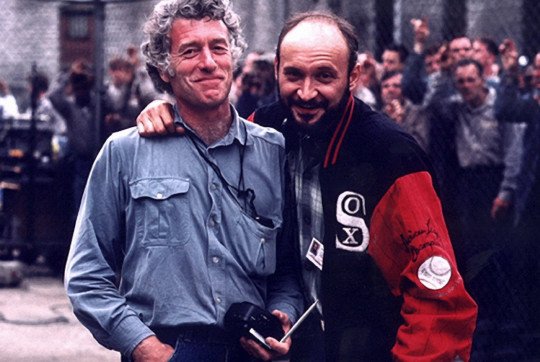
Frank Darabont talks about his childhood as a refugee and immigrant; his youthful attraction to horror and fantasy; and the events and influences that lead him to pursue a career as a filmmaker. Darabont also talks his first movie jobs as a crew member on low budget horror films like Hell Night (1981); his first work as a screenwriter and director; and adapting the work of Stephen King. Continuing his chat with fellow writer-director Mick Garris, Darabont talks about his film The Mist (2007), and currant state of motion picture art and industry. In the conclusion of his interview, Darabont discusses sequels and remakes; career highs like The Shawshank Redemption (1994) and Saving Private Ryan (1998), and disappointments like Mary Shelly’s Frankenstein (1994); and how time is the ultimate judge of quality.
“If you have a dream, get up off your ass and start putting one foot in front of the other”
72 notes
·
View notes
Text
How Netflix & Amazon Aren’t Just Changing the Game But Making TV Irrelevant
I remember clearly the conversation I had with my eldest son, now 28, when he moved into his first apartment several years ago. I wanted to know when I should arrange for the cable company to come and do an installation.
“Oh, I’m not getting a cable subscription,” he said.
“You’re getting a satellite dish?” I replied.
“No, neither. I download everything I want to watch.”
And so it was that I discovered how the younger generation watched television—it didn’t. It was downloading; it was streaming; in many instances, it wasn’t paying for the privilege. And the one thing it no longer had any use for? An actual TV set.
This fall saw the addition of another layer of pending obsolescence to the television equation when the consensus critics’ choice for best new series of the season wasn’t on network TV, basic cable, or even premium cable. It’s streaming on Amazon Studios (free with an Amazon Prime subscription).
In case you haven’t heard, the show is called Transparent, a dramedy starring Jeffrey Tambor as the aging patriarch of a dysfunctional Los Angeles family who adopts a transgender identity. From Six Feet Under producer Jill Soloway it’s a bracing, innovative piece of programming. Like its lead character, it cannot be easily identified or categorized. It has comedy. It has drama. It has heart. It has pathos.
It also has no conventional network to call its own while streaming across our computer monitors, tablets, and smart phones. Instead, in the latest gambit changing up the content/viewing game, Transparent is made available not a single episode at a time but all at once, the 10 episodes from season one there for the binging since last week.
This is the same arrangement Netflix pioneered with its original series, which include House of Cards, Orange is the New Black, Derek, Hemlock Grove, Lilyhammer, and the animated BoJack Horseman. Besides its breakthrough Transparent, Amazon has the second season of its political satire Alpha House coming out on October 24—again, all 10 episodes at once.
If you think ABC, NBC, CBS, Fox, the CW, HBO, and Showtime aren’t hearing footsteps, you’d be wrong. It’s not for nothing that HBO and Showtime are pouring so much money into making on-demand services like HBO Go and Showtime Anytime players in their own right. Having entities that are available anywhere, anytime isn’t just about convenience, but survival. The day isn’t far off when the on-the-go iteration of a network will be more popular than the television version that spawned it.
“This isn’t just a case of a bold new competitor emerging on the content landscape,” said one industry analyst. “It’s a genuine game-changer in the way it challenges the status quo. Because now that streaming services are starting to reach quality parity with the best programmers, it’s literally altering audience viewing habits in a real way. It gets people out of the habit of automatically reaching for the remote. And that’s huge.”
As with premium cable outlets, Netflix and Amazon have several significant and obvious advantages over their broadcast rivals when distributing original content. They don’t need to sell concepts for approval by affiliated stations; they need not worry about scrutiny from advertisers, since there aren’t any. They’re given even greater flexibility by their ability to distribute content worldwide on a single stream; their delivery system is limited only by the reach of the Internet.
But there’s another, more vexing way in which streamers are shaking up the original content equation. Neither subscribe to a conventional ratings measurement service like Nielsen, and neither has released whatever internal ratings info they may have. Netflix boss Ted Sarandos has referred to television ratings as an “irrelevant benchmark.” If that’s true, it still remains the sole criterion for the way tens of billions in ad revenue gets split up. Of course, critics and competitors in the television landscape charge that if Netflix and Amazon’s internal viewer numbers weren’t miniscule, they would scream about it from the highest mountain. But any guesswork about actual numbers is precisely that: a guess.
Certainly, the hefty investment in original series programming is catching everyone’s eye. Netflix, Amazon, and Hulu have combined spent more than $1 billion this year as they ramp up that area of their content. Word came down this week that Adam Sandler will be developing four new movies exclusively for Netflix, which may or may not be seen as a good thing, depending on one’s view of Adam Sandler. It’s all part of a Netflix commitment of more than $6 billion to film and TV content over the next three years. A major European expansion also is in the works.
The bottom line is that Netflix and Amazon both have deep pockets and aren’t afraid to reach into them as the return on investment begins to materialize via increased buzz, cache, and subscribers—if not yet revenue.And it tells us that the role of the television screen in our future is growing increasingly murky, if not altogether obsolete.
Of course, any 20-year-old could have told us that.
Original article by Ray Richmond
2 notes
·
View notes
Video
The Machine: Bait Studio VFX Showreel from Bait Studio on Vimeo.
We were the lead visual effects team for this stylish British sci-fi thriller directed by Caradog James, contributing nearly 250 VFX shots. One of the biggest challenges was matching the classic anamorphic lenses that were used on the Arri Alexa cameras during the shoot, our VFX Supervisors were on hand throughout principal photography to support the crew.
Work included matte paintings, set extensions, eye glows, explosions and green-screen car exteriors. One of the stand out scenes opens the film, featuring CG make up for a wounded character who is missing part of their skull. We also designed and composited all the futuristic interactive screens in the film, animating the graphics in Adobe After Effects before compositing all the shots with The Foundry's Nuke.
Following a successful Premiere at the TriBeCa Festival, The Machine has gone to win 3 BAFTA Cymru Awards, and was voted Best UK Feature at the Raindance festival. The film was released in cinemas and on VOD in March 2014.
"It’s all accompanied by some impressive visual effects work for a smaller, independent film"
"...while transparent touch interfaces abound they feel more realistic than Minority Report’s sweeping hand gestures ever did." (The Verge)
See more of our work at baitstudio.com/
0 notes
Video
youtube
“There are people whose ideas are so strong that they seem to glow with creativity. McQueen is one of them.” —Telegraph
The director of ‘Shame, ‘Hunger,’ and ‘12 Years a Slave’—films known for boundary-pushing performances and true-life subject matter—discusses his work spanning the worlds of art and cinema with Stuart Comer, the new chief curator of media and performance art at the Museum of Modern Art, New York. Hailed in a 2010 New York Times headline as an “Intense Seeker of Powerful Elegance,” Steve McQueen has become known for his formalism and his willingness to engage with controversial content in powerfully human ways. This dialogue marks McQueen’s first visit to the Walker Cinema.
“We all try to understand what are other filmmakers secrets: how did they start, how did they find money, how did they secured distribution, how did they learn to make movies etc. even though we know that, ultimately, a story never repeats twice. This is particularly true with Steve McQueen, who didn’t follow the ‘traditional route’ (proof is that this 2h conversation happens in an Art Museum with a curator, vs. a theater with a ‘moderator’). I am so used to hear stories of filmmakers either coming from the music videos/commercials or the Festival route, that I never thought there was a third way to go: the Art World. And that’s where McQueen comes from, which makes him all the more fascinating.”
“Because he had no money to shoot feature films, McQueen started shooting short films that (for reasons that are not explained) made it through the Art World and Galleries. Steve McQueen shot 11 short films before Hunger, between 1993 and 2007. It seems that from the get go his first short film, The Bear (1993) gained attention and his fame in the Art World increased until he won the Turner Prize in 1999.
Watch right below ‘Illuminer‘, a video shot in 2002 where McQueen lays on a bed in a hotel room in the dark, while his body reflects the light produced by the TV news about the war in Afghanistan.” —Nathalie, Mentorless
Reads/Watches/Listens:
John Ridley’s screenplay for ‘12 Years a Slave’ (Fox Searchlight)
Steve McQueen & Abi Morgan’s screenplay for ‘Shame’
Enda Walsh & Steve McQueen’s screenplay for ‘Hunger’
The DGA 23rd annual ‘Meet The Nominees: Feature Film’
The confessions of Steve McQueen
Steve McQueen: my hidden shame
Artist Talk: Steve McQueen
The early work of Steve McQueen
Steve McQueen’s 2002 South Africa mining film ‘Western Deep’
Excerpt clip from Steve McQueen’s 1999 Turner Prize winning silent film ‘Deadpan’
For more film related items throughout the day, follow Cinephilia & Beyond on Twitter. Get Cinephilia & Beyond in your inbox by signing in. You can also follow our RSS feed. Please use our Google Custom Search for better results. If you enjoy Cinephilia & Beyond, please consider making a small donation to keep it going:
// <![CDATA[ // ]]>
194 notes
·
View notes
Photo
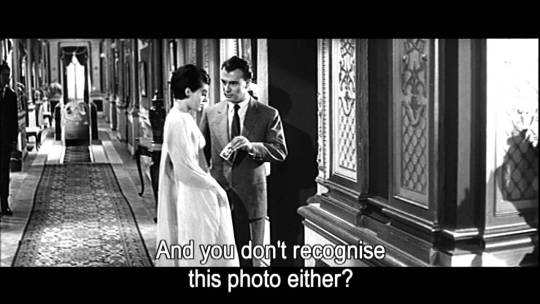
The 50 Definitive Original Screenplays
What makes a brilliant script? Is it quotable lines? Is it nuanced dialogue? Or is it just the ability to move the story along and not get in the way? When looking back through the history of screenwriting, there are plenty of iconic films based on previous work; the Writer’s Guild of America voted Casablanca the greatest screenplay of all time, but it’s adapted. So, what is the most important piece of film writing ever written directly for the screen? This list will shift from American to international, conventional to unconventional. Most importantly, these are the scripts that demonstrate how “screenwriting from scratch” is done.
Click here to see the liast
17 notes
·
View notes
Video
youtube
“French-German TV channel, ARTE, shows part of an interview for ‘Cinéma cinémas’ in 1983 with Martin Scorsese being driven from his place to the airport. Marty’s on his way to the airport to go present his film, ‘The King of Comedy,’ at the Cannes International Film Festival. This is what Marty looked like when Thelma first introduced me to him while we were working on ‘After Hours.’” —Hector Cordero
“The short version of the story goes like this. In 1960, Michael Powell of the famed Powell & Pressburger directorial team, struck out on his own and helmed ‘Peeping Tom.’ The result? Critics and British industry savaged the movie at the time, and he found himself essentially excommunicated and exiled. However, he was championed by the new school of American filmmakers, Martin Scorsese, in particular. It was through him that he met his future wife, editor Thelma Schoonmaker, and the rest is history. The interwebs serves a brief but lovely document of their friendship, as some footage of Powell visiting Scorsese on the set of ‘The King of Comedy’ has surfaced. It seems to be an excerpt from a longer documentary about Powell, but regardless, it’s quick glance behind the scenes of Scorsese’s film as well as some kind words from the director about his hero. It’s some pretty charming stuff all around. Give it a spin below.” —The Playlist
TheSheik1976 also reupload footage of Powell and Francis Ford Coppola touring Zoetrope Studios, watch below.
// <![CDATA[ // ]]>
52 notes
·
View notes
Video
vimeo
Embedded above is a fascinating video of Thelma Schoonmaker's editing techniques in the films of Martin Scorsese, featuring examples from ‘Taxi Driver,’ ‘Raging Bull,’ ‘Goodfellas, and more. Scorsese praises his editor for her tenacity in finding the emotion of a scene. She doesn’t ever read the script, so she can have “a cold and objective point of view.”
Kristopher Tapley recently sat down with Schoonmaker to discuss the appearance and editing style of ‘Wolf of Wall Street’ and learning from Martin Scorsese. “Anyone with a passion for cinema, I imagine, will fight the urge to bow at the feet of a woman like this, who has been such a consistent force behind some of the most indelible film imagery of our time.” —Thelma Schoonmaker talks cutting ‘Wolf of Wall Street’ improv and learning from Martin Scorsese
Marty was quoted the other day as saying we’ve been working together for half a century, which is pretty staggering! I said, “My God.” Actually there were 10 years when I couldn’t work with him because I wasn’t in the union out here. When he came out here we didn’t have to be in the union back there [in New York]. And then finally on “Raging Bull” I got in. But yeah, I mean who knew when I first met him that this would happen? It changed my life. I would never, probably, have become a filmmaker. It was just a summer course and I had wanted to become a diplomat. The state department told me I was too liberal. I passed all the exams and they said I was too liberal, I would be very unhappy there. So I took a job with this horrible guy who was butchering the films of Fellini, Truffaut for late-night television slots. And it was so awful, that job, that I saw an ad for a six-week course and I thought, “Well, I can just barely afford that.” And there was Marty. I could’ve just taken that six-week course and it would have been a lark and I would have gone on to something else, but because I met him my whole life changed. —Thelma Schoonmaker
For more, see our archive under the tag, “Thelma Schoonmaker.”
Subscribe to Cinephilia & Beyond by Email
// <![CDATA[ // ]]>
131 notes
·
View notes
Photo
I studied film at the University of Southern California for a very short time, but USC left me feeling like I didn’t have any talent. I really didn’t find their methods of teaching were that interesting or exciting. That lack of interest made me start to doubt myself and whether I had made the right choice. I simply said to myself, “Okay, I tried, but I didn’t make it.” I went back to my old job as an engineer… I found a job in Seattle designing computers [at the University of Washington], and started working from eight to five. By the time I was thirty, I felt so old…
One night, I was driving after work in downtown Seattle, and I saw a billboard outside a movie theater with the words, German New Wave, and the title, Aguirre: The Wrath of God. It made me curious, so I went in. I was fortunate. I came out a different person. That two hours just blew me away. It restored my sense of competence that I could be a filmmaker. This is what I thought a film should be. Film school would never teach you to make those kind of shots. That was one of the crucial moments of my life. I had turned thirty, I thought I was getting old, and three more years passed before I got the chance to work on a film project with a friend who asked me to write a script for him. I went back to Taipei, and also visited Hong Kong for the first time, and the film was shot in Japan. I got an offer to write and direct a made-for-TV movie in Taiwan, so I didn’t go back to Seattle. After ten years my mom was still calling and asking, “When are you coming back to your regular job?”
— Edward Yang
Yep. Film school sucks.


321 notes
·
View notes
Photo
Looking forward to this one...
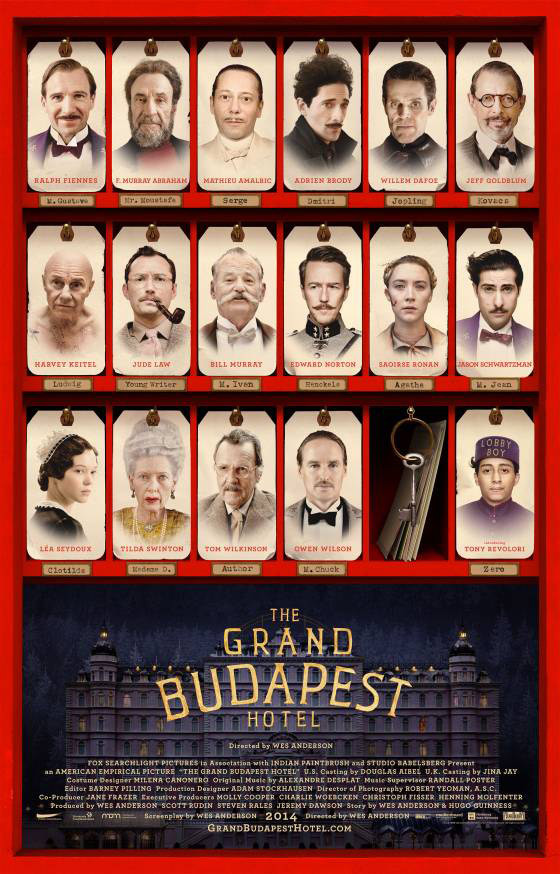
Watch this: ‘The Grand Budapest Hotel’, from Wes Anderson, releases a new trailer
30 notes
·
View notes
Text
Is VOD the Future of Independent Film? Yes -- and No.
Netflix chief content officer Ted Sarandos riled the industry with a contentious Executive Keynote address at the 9th annual Film Independent Forum, in which he criticized theater owners for resisting the idea of day-and-date releasing of films on Netflix and claiming that theaters are going to "kill movies" if they continue to resist multi-platform distribution.
John Fithian, president/CEO of the National Association of Theater Owners responded, telling Deadline that, in fact, Netflix was imperiling the future of movies. "Subscription movie services and cheap rentals killed the DVD business, and now Sarandos wants to kill the cinema as well," Fithian said.
After getting flak from theater owners about his bold statement, Sarandos backtracked, saying that he wasn't calling for day and date, but rather, "calling to move all the windows up to get closer to what the consumer wants."
Mainstream exhibitors refuse to carry films that premiere day-and-date, saying that there is a direct hit on theatrical exhibition when movies play day-and-date.
But some independently owned and operated theaters don't have a problem with the new distribution model. "I do wish more theaters would be open to supporting day and day releases for indie films," said Tim League, founder/chief executive officer of Alamo Drafthouse Cinema.
As he told Indiewire recently: "Alamo Drafthouse is one of the few exhibitors that supports the idea of day and date and even ultra-VOD windows. I am a open to this for small movies by small distributors who don't have the budget for a massive national P&A spend. We have proven that model can work for the right film."
It's clear that day-and-date continues to be a hot-button issue for the industry -- big-budget and indie movies alike.
"Escape From Tomorrow."
Sarandos' comments come just as many independent films challenge the traditional theatrical model with multi-platform releases, including day-and-date VOD releases and ultra-VOD.
As these distribution methods lose their stigma, they're becoming standard for many small films.
Depending on who you ask, VOD is either the salvation -- or the death -- of independent film.
Of course, the Netflix model, where consumers pay a flat rate upfront, is quite different than video on demand, or from renting or buying a film from a digital store such as iTunes, Amazon Instant Video, Hulu, or from sites such as Crackle and Indiewire's parent SnagFilms, where you can stream movies for free.
It's unlikely that Hollywood studios and theater owners will ever agree to having films stream day-and-date on Netflix or on VOD: By all appearances, it would destroy their business model.Independent films potentially have more to gain with day-and-date releases than blockbusters -- a larger potential audience and the ability to generate word-of-mouth -- but the risk remains.
If audiences can watch a new release at home, why go to the local theater?
Whatever Sarandos may want, it's clear that viewing habits are changing. The younger generation wants the convenience and flexibility of watching films whenever and wherever they want-- whether it's on their mobile device, tablet or streaming directly to their TV.
"Concussion" on VOD
VOD provides a potential audience of 100 million in North America alone, estimates Nolan Gallagher, CEO and founder of Gravitas Ventures.
"Not every great movie is going to necessarily get to Cleveland," said Gallagher, and "there are quite a few consumers who like to be the first ones to see movies fresh off their festival debut.
"Concussion," the Sundance hit from first-time feature director Stacey Passon, is only playing at select theaters, but it's available on iTunes and other VOD platforms.
The list of high-profile indies to be released day and date in the past few months alone is long and includes "Escape From Tomorrow," "Lovelace," "The Canyons," "A Teacher," "Adore," Drinking Buddies," "Don't Stop Believin'," "Touchy Feely," "Ain't Them Bodies Saints," "Blue Caprice," "Muscle Shoals," "Good Ol' Freda" and many other films that made the festival circuit.
Then there are films like James Franco's "As I Lay Dying," a prestige pic that (aside from a single Manhattan screening) bypassed its theatrical release and went straight to VOD, iTunes and DVD. With a recognizable title, Cannes credentials, built-in publicity and Franco's star power, the film should fare decently on digital platforms, whereas it would have been a tough title theatrically.
Radius-TWC distributed the low-budget, R-rated comedy and Sundance hit "The Bachelorette" via the "ultra" model a month before its theatrical release in September as a way to market the film and create buzz. The film, which starred Isla Fisher and Kristen Dunst, immediately climbed atop the iTunes "top movies" chart.
Recently, Magnet Releasing, a division of Magnolia Pictures, did the same for "The Last Days on Mars," the sci-fi thriller starring Liev Schrieber. The movie was available on VOD five weeks before its theatrical release in December and hit the top 10 in the list of iTunes Indies. Magnolia Pictures used the same strategy recently with "Mr. Nobody."
The specialty industry is clearly torn when it comes to the VOD future. Fear of cannibalization is strong, not only in terms of theatrical attendance but because VOD releases currently don't generate the same kind of PR and marketing push. The advent of digital projection hasn't made theatrical releasing any less expensive and it's harder to make back the money in ancillary rights.
Since the introduction of television, people have been declaring the death of cinema, but so far, nobody has been able to replicate the immersive, communal theater going experience at home.
"Whether you see day and date as half empty or half full -- as cannibalization or cross-promotion -- It's going to take a lot more than protectionism against ancillary overlap to keep folks going to the movies," said Richard Lorber, chairman and CEO of Kino Lorber.
The fact is that despite fears that day-and-date will kill movie going, there's no data to prove that day-and-date is eating into theater grosses (although theater owners say they can see the evidence in box office receipts over the past eight years or so).
"There are separate audiences for theatrical and VOD and the cross over is slim as the experience of seeing a movie in theaters is so different than watching at home," said Matt Grady, founder of specialty distributor Factory 25. "There are people who go to movies and others who watch films on VOD and hopefully both audiences can grow with press generated from each."
There's also a sense that, to some degree, since viewing habits are changing, you have to give the people what they want.
"I think VOD represents part of the future for indie film," said Oscilloscope Laboratories' David Laub. "Is it the entire future? I don't feel we have enough data yet to know that."
There is, however, enough data to know that more audiences are watching on VOD.
Set-top boxes with on-demand viewing capabilities are now in about 60% of U.S. households, up from 37% in 2008, according to a recent report from Nielsen. Overall, about 102.7 million homes had pay-TV service from a cable, satellite or telephone company in the second quarter of 2013, according to Nielsen's Viewing on Demand report.
The report also found that younger viewers are more likely to use VOD; about 31% of those ages 18-34 told Nielsen they used it, compared with 23% of those 35 and older.
What's also evident is that some films lend themselves to day and date more than others. Laub points to two recent Oscilloscope releases to prove this point. They decided not to do a day and date release for "Mother of George,"because "it's not an automatic draw," said Laub. "We loved the movie when we saw it and the reviews exceeded our expectations, but it needs to be nurtured."
A film like "28 Hotel Rooms" was a natural for day and date release, said Laub, pointing out that its title was a big plus (films that start with numbers or letters early in the alphabet tend to do well on VOD).
"About Cherry," starring James Franco, Heather Graham and Dev Patel, opened in only three theaters last year, but scored on VOD, where it made over $500,000 in the first week across all VOD platforms, according to the film's distributor IFC Films.
But a successful VOD run and a successful theatrical run don't have to be mutually exclusive; one benefit of a day-and date release is the publicity surrounding the theatrical release also benefits VOD platforms.
"You can still be successful in both realms if you have the right marketing campaign, the right film and the right release strategy. They can feed each other," said Laub.
"Margin Call," the 2011 film directed by J.C. Chandor and starring Kevin Spacey, Stanley Tucci, Paul Bettany and Jeremy Irons, was a high-profile example of a film that had success in both theaters and on VOD. But even with that film, there's a question of whether it would have done better in the theater had it not been available on VOD.
Unlike theatrical releases where box office receipts are publicly reported, in general, VOD numbers are not released, which makes it tricky to gauge success -- except when companies choose to trumpet their successes.
That may change; John Sloss led the charge by releasing VOD figures for "Escape from Tomorrow" and urging other distributors to do the same. Radius-TWC followed suit by releasing the VOD figures for "Man of Tai Chi," which went the ultra-VOD route.
"The Perfect Family"
Gallagher points to "The Perfect Family," starring Kathleen Turner, Emily Deschanel and Jason Ritter, which was released on VOD and in theaters in May 2012, as a day and date success story, saying it did "over six figures in the theater and very, very well on VOD."
Releasing a film theatrically is expensive; historically, if the theatrical release wasn't a success, distributors would have to wait three months or longer to release the film on DVD or elsewhere. But now, distributors can coordinate all of the publicity efforts for the theatrical release to include the on-demand release.
"Most independent films aren't sitting on large marketing budgets, so to be able to market both a theatrical and VOD release at the same time is very efficient," said Gallagher.
Built-in name recognition or name stars also help VOD titles (as opposed to something like "Mother of George," where the title doesn't indicate exactly what it's about and there are no stars in the cast).
Berry Meyerowitz, president and CEO at Phase 4, points to the "ultra" release of films like "Only God Forgives" as leading the charge.
"When you have big stars like Ryan Gosling in movies going on demand, people are starting to get it," he said. "Movies that have done well on VOD have titles where you know exactly what it's about, like 'Assault on Wall Street.' "The more descriptive we can be, the better."
In the past, filmmakers might be reluctant to have a day and date release and some do still prefer theatrical windowing. But, as Laub points out, "A lot of filmmakers are increasingly open to these new models.
Terence Malick's last movie ("To The Wonder") was released day and date in April. There are legitimate success stories with films like 'Margin Call,' which went day and date. I've seen more openness to it over time."
In the case of "Good Ol' Freda," director Ryan White had no problem with the film being released day and date, especially since music documentaries tend to do well in VOD.
Freda Kelly in 'Good ol' Freda'
"Our niche audience is Beatles fans who are throughout the country. It's a film for the fans. I didn't just want it to be available to people in the big cities. We wanted it to be democratic, with people being able to see it right away,"White told Indiewire.
"More and more filmmakers understand," said Meyerowitz. "Exhibitors are starting to understand as well. If it's going to work, we need more exhibitors to buy into the notion that a bigger pie is better for everyone. Some movies will find an audience on demand and some movies will find an audience in theaters."
Of course, the less of a stigma there is surrounding a VOD or day-and-date release, the more VOD releases we'll see -- especially as fewer small films have a shot at theatrical distribution -- which means there's already a glut of VOD releases vying for attention.
So is VOD the future for indies? Only time will tell.
Original article by PAULA BERNSTEIN here.
#netflix#ted sarandos#film independent forum#john fithian#national association of theater owners#alamo drafthouse#vod#escape from tomorrow#snagfilms#amazon instant video#hulu#crackle#gravitas ventures#nolan gallagher#sundance#james franco#magnet releasing#magnolia pictures#david laub#oscilloscope#heather graham#dev patel#margin call#j.c. chandor#kevin spacey#stanley tucci#paul bettany#jeremy irons
0 notes
Photo
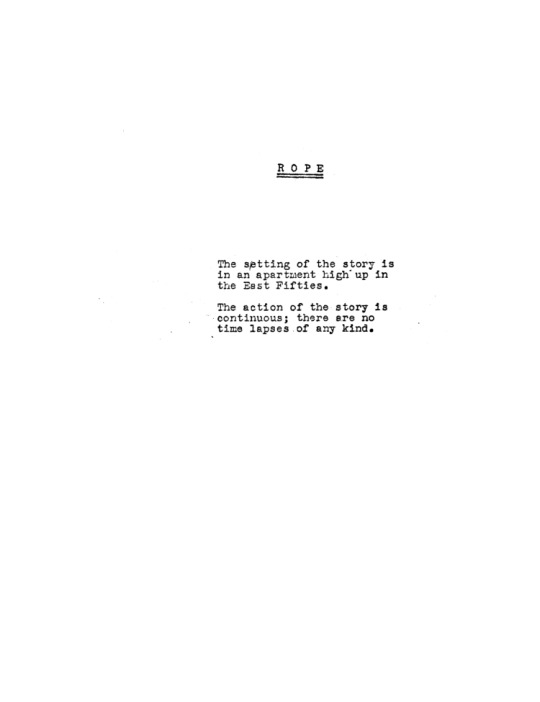
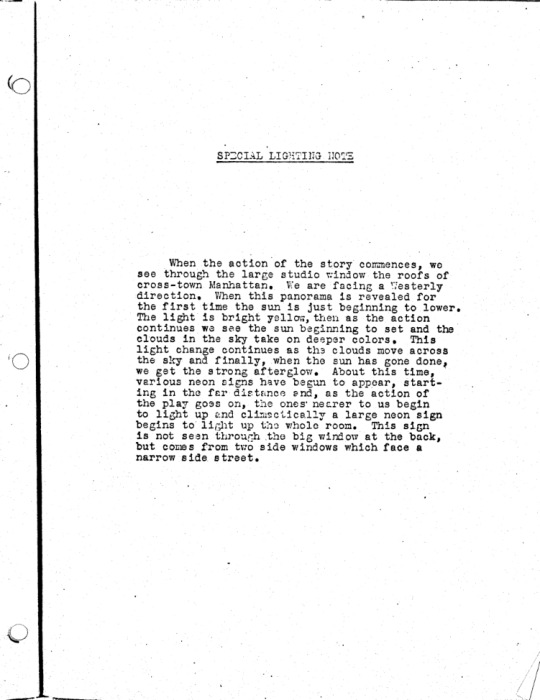
“Brandon, how did you feel?”
“When?”
“During it?”
—Philip Morgan to Brandon Shaw
This one is a gem, Arthur Laurents's screenplay for Rope, a 1948 Alfred Hitchcock film based on the play by Patrick Hamilton [pdf]. (NOTE: For educational purposes only)
ROPE (1948) is Alfred Hitchcock’s murder/suspense film that showcases the killing in its second shot. ROPE is often described as having no editing… a film that plays out in real-time… but it had to hide the cuts due to the 10-minute film reel limits of the day. On further examination… Hitchcock’s gem actually contains 10 edits. Five of them are hidden as the camera lens is filled by foreground objects. The other five edits are regular hard cuts that not many people either realize or acknowledge. I’ve isolated all 10 edits in the video below so you can learn from the Master of Suspense on how to hide your edits without losing momentum in your story. I always knew that some of the cuts were hidden by camera wipes… but never realized there were 5 hard cuts hiding in plain view! It’s also interesting to note that the 10 edits switch between hard cut and dissolve in an alternating pattern. Was this done to maintain a subconscious rhythm to the editing? Was it accidental? I would find it hard to believe that Hitchcock left anything to chance… —Vashi Nedomansky
For further reading and viewing:
Filmic space and real time in Alfred Hitchcock’s Rope
Hidden in Plain Sight
All the essential documentaries on Alfred Hitchcock
// <![CDATA[ // ]]>
102 notes
·
View notes
Photo
Known primarily for his revenge triptych, South Korean auteur, Park Chan-Wook, has rightfully earned a reputation for high-drama punctuated with devastating violence. What’s less often talked about is his thematic and stylistic range. The final images collected here are from a procedural, a pair of revenge melodramas, a rom-com, a horror, and a psychological thriller. They all clearly demonstrate a diverse, highly poetic filmmaker with very deliberate visual pallet.
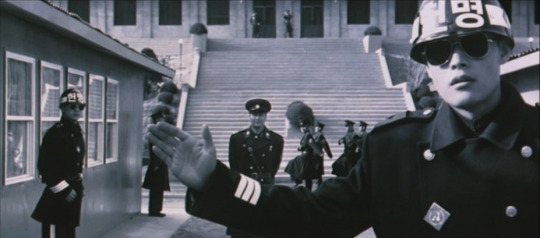
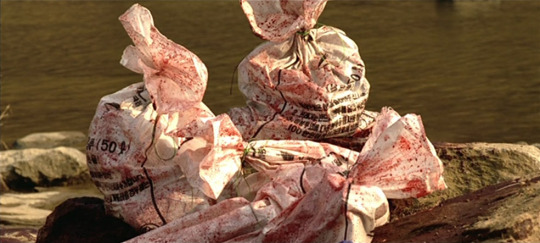




263 notes
·
View notes